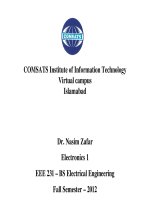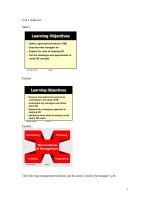Organizational behavior: Lecture 10 - Dr. Mukhtar Ahmed
Bạn đang xem bản rút gọn của tài liệu. Xem và tải ngay bản đầy đủ của tài liệu tại đây (530.25 KB, 39 trang )
Organizational
Behavior
(MGT-502)
Lecture-10
Summary
of
Lecture-9
What Are Emotions?
Affect
Affect
AAbroad
broadrange
rangeof
ofemotions
emotions
that
that people
peopleexperience.
experience.
Emotions
Emotions
Intense
Intensefeelings
feelingsthat
thatare
are
directed
directedat
atsomeone
someoneor
or
something.
something.
Moods
Moods
Feelings
Feelingsthat
thattend
tendto
tobe
beless
less
intense
intensethan
thanemotions
emotionsand
and
that
thatlack
lackaacontextual
contextual
stimulus.
stimulus.
Felt versus Displayed
Emotions
Felt emotions
An individual’s actual emotions.
Displayed emotions
Emotions that are organizationally
required and considered appropriate
in a given job.
Facial Expressions Convey
Emotions
Today’s Topics
Individual BehaviorPerception
Perception
Perception
Perception
Perception
• What is Perception?
– A process by which individuals organize
and interpret their sensory impressions in
order to give meaning to their
environment.
• Why Is it Important?
– Because people’s behavior is based on
their perception of what reality is, not on
reality itself.
– The world that is perceived is the world
that is behaviorally important.
Basic Elements in the
Perceptual Process
Environmental
Stimuli
Perceptual Selection
* External factors
* Internal factors
Interpretation
* Perceptual errors
* Attributions
Observation
* Taste
* Hearing
* Touch
* Smell
* Sight
Perceptual
Organization
* Perceptual
grouping
Response
Perceptual process model
Environmental stimuli
Feeling
Hearing
Seeing
Smelling
Selective attention
Organisation and
interpretation
Emotions and
behaviour
Tasting
Points about Perception
Perception is the process by which you
give meaning to your environment by
organizing & interpreting stimuli into a
psychological experience.
Because perception varies across
individuals, people see the same thing
in different ways.
In the eye of the beholder
• Process of response to
environmental stimuli
– Selection
– Organization
• No two people will
necessarily perceive
situation the same
• Individuals base behavior
on perceived reality
Perception
• A cognitive process: lets a person make
sense of stimuli from the environment
• Affects all senses: sight, touch, taste,
smell, hearing
• Includes inputs to person and choice of
inputs to which the person attends
• Stimulus sources: people, events,
physical objects, ideas
• Helps adaptation to a changing
environment
Factors Influencing
Perception
• The Perceiver
• The Target
• The Situation
Factors that Influence Perception
Factors
Factorsininthe
thesituation
situation
••Time
Time
••Work
Worksetting
setting
••Social
Socialsetting
setting
Factors
Factorsininthe
thePerceiver
Perceiver
••Attitudes
Attitudes
••Motives
Motives
••Interests
Interests
••Experience
Experience
••Expectations
Expectations
Perception
Perception
Factors
Factorsininthe
thetarget
target
••Novelty
Novelty
••Motion
Motion
••Sounds
Sounds
••Size
Size
••Background
Background
••Proximity
Proximity
Perceptual Selection
• Filtering process so we can focus
only on important stimuli
• Depends on 2 major factors
– External environment
– Internal to the one perceiving
External Factors
• size
• Intensity (brightness, loudness, etc)
• Contrast
• Motion
• Repetition- Repetition- Repetition• Novelty/Familiarity
Contrast Effect
Internal Factors
• Personality –
Person Perception
• Learning
– Perceptual Set
• Motivation
– Inner needs









